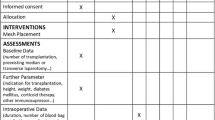Abstract
Background: The literature provides no data on the incidence and operative management of incisional hernias developing after orthotopic liver transplantation. The use of high-dose immunosuppressive agents results in an appreciable delay in wound healing. There is thus a need for a procedure for the reconstruction of the abdominal wall for patients on immunosuppression. The aim of this retrospective study was to establish the incidence of incisional hernias and an analysis of the results after implantation of a polypropylene mesh in inlay–onlay technique after liver transplantation is given.
Methods: The basis for the present retrospective investigations was a total of 207 liver transplantations carried out in 192 patients (15 re-transplantations). After performing tensiometry, a polypropylene mesh (Marlex) was implanted to close the hernias using the inlay/onlay technique or a direct closure of the fascia was done. All treated hernias were followed up for a median of 18 months.
Results: Among 184 patients, 17 developed incisional hernias after primary direct closure of the abdominal wall, giving an incidence of 9%. In an additional 8 patients an incisional hernia was seen where an absorbable mesh was used to close the abdominal wall after liver transplantation. In addition, there were 25 incisional hernias after 207 liver transplantations (12%). One of 15 (7%) of the surgically repaired hernias with implantation of a polypropylene mesh (Marlex) developed a recurrence. All the 3 patients after direct apposition of the fascia without using a polypropylene mesh suffered a recurrence (3 of 3; 100%). Significant risk factors for developing an incisional hernia were the amount of ascites and the stay in the ICU after transplantation. Neither severe deep nor superficial wound infection nor bowel fistulas were observed after implantation of a inlay/onlay mesh.
Conclusion: In patients after liver transplantation, the implantation of a polypropylene mesh proved to be an efficient and safe method of treating incisional hernias. Implantation of a mesh was not associated with an increased infection rate, despite the use of immunosuppression. In view of the high recurrence rate associated with primary closure, mesh implantation should be given preference.


Similar content being viewed by others
References
Adloff M, Arnaud JP (1987) Surgical management of large incisional hernias by an intraperitoneal Mersilene mesh and an aponeurotic graft. Surg Gynecol Obstet 165:204
Bauer JJ, Salky BA, Gelernt IM, Kreel I (1987) Repair of large abdominal wall defects with expanded polytetrafluoroethylene (PTFE). Ann Surg 206:765–769
Belghiti J, Durand F (1997) Abdominal wall hernias in the setting of cirrhosis. Semin Liver Dis 17:219–226
Blacher A, Federle MP, Dodson SF (2001) Bowel obstruction following liver transplantation. Clinical and CT findings in 48 cases with emphasis on internal hernia. Radiology 218:384–388
Condon RE (1995) Incisional hernia. In: Nyhus LM, Condon RE (eds) Hernia, 4th edn. Lippincott, Philadelphia, p 319
Champetier J, Letoublon C, Chaland P (1990) The repair of recurrent incisional hernias. Objectives and indications. J Chir (Paris) 127:191
Ehrlich HP, Hunt TK (1968) Effects of cortisone and vitamin A on wound healing. Ann Surg 167:327–328
Holla RK, Sequeira RP, Kulkarni D (1985) Cyclosporine and wound healing. Gynecol Obstet 160:135–139
Kaufmann Z, Engelberg M (1981) Fecal fistula: a late complication of Marlex mesh repair. Dis Colon Rec 24:543–544
Klein P, Konzen G, Schmidt O, Hohenberger W (1996) Reconstruction of scar hernias: intraoperative tensiometry for objective determination of procedure of choice. Chirurg 67:1020–1027
Liakakos T, Karanikas I, Panagiotidis H, Dendrinos S (1994) Use of Marlex mesh in the repair of recurrent incisional hernia. Br J Surg 81:248–249
Lichtenstein IL, Shore IM (1976) Repair of recurrent ventral hernias by an internal "binder". Am J Surg 132:121–125
Maggi U, Rossi G, Colledan M, Fassati LR, et al (1991) Major surgical complications after 73 consecutive liver transplantations. Ann Chir 45:476–479
Matapurkar BG, Gupta AK, Agarwal AK (1991) A new technique of "Marlex-peritoneal sandwich" in the repair of large incisional hernias. World J Surg 15:768–770
Molloy RG, Moran KT, Waldron RP, Brady MP, Kirwan WO (1991) Massive incisional hernia: abdominal wall replacement with Marlex mesh. Br J Surg 78:242–244
Ott R, Gralka S, Born G, Müller V, et al (1998) Low rejection rate after hepatic transplantation achieved with a cyclosporin-based quadruple immunosuppressive regimen. Transplant Proc 30:1427–1429
Reingruber B, Kastl S, Stremmel C, Klein P (2001) Incisional hernia repair: tensiometry for the selection of the appropriate procedure. Eur J Surg 167:903–908
Schumpelick, Klinge U, Welty G, Klosterhafen B (1999) Meshes within the abdominal wall. Chirurg 70:876–887
Stoppa RE (1989) The treatment of complicated groin and incisional hernias. World J Surg 13:545
Sugerman HJ, Kellum JM, Reines HD, Maria EJ de (1996) Greater risk of incisional hernia with morbidly obese than steroid-dependent patients and low recurrence with prefascial polypropylene mesh. Am J Surg 171:80
Trupka AW, Hallfeldt KKJ, Schmidbauer S, Schweiberer L (1998) Incisional hernia repair with an underlay polypropylene mesh plasty: an excellent technique from French hernia surgeons. Chirurg 69:766–772
Usher FC, Fries JG, Ochsner JL, Tuttle LLD (1959) Marlex mesh, a new plastic mesh for replacing tissue defects. Arch Surg 78:131–145
Usher FC (1961) Hernia repair with Marlex mesh: an analysis of 541 cases. Arch Surg 84:73
Vestweber KH, Lepique F, Haaf F, Horatz M, Rink A (1997) Results of recurrent abdominal wall hernia repair using polypropylene mesh. Zentralbl Chir 122:885
Zimmermann G, Müller G, Haid A (1991) Surgical therapy of incisional hernias. Chirurg 62:656–662
Author information
Authors and Affiliations
Corresponding author
Rights and permissions
About this article
Cite this article
Müller, V., Lehner, M., Klein, P. et al. Incisional hernia repair after orthotopic liver transplantation: a technique employing an inlay/onlay polypropylene mesh. Langenbecks Arch Surg 388, 167–173 (2003). https://doi.org/10.1007/s00423-003-0384-4
Received:
Accepted:
Published:
Issue Date:
DOI: https://doi.org/10.1007/s00423-003-0384-4




